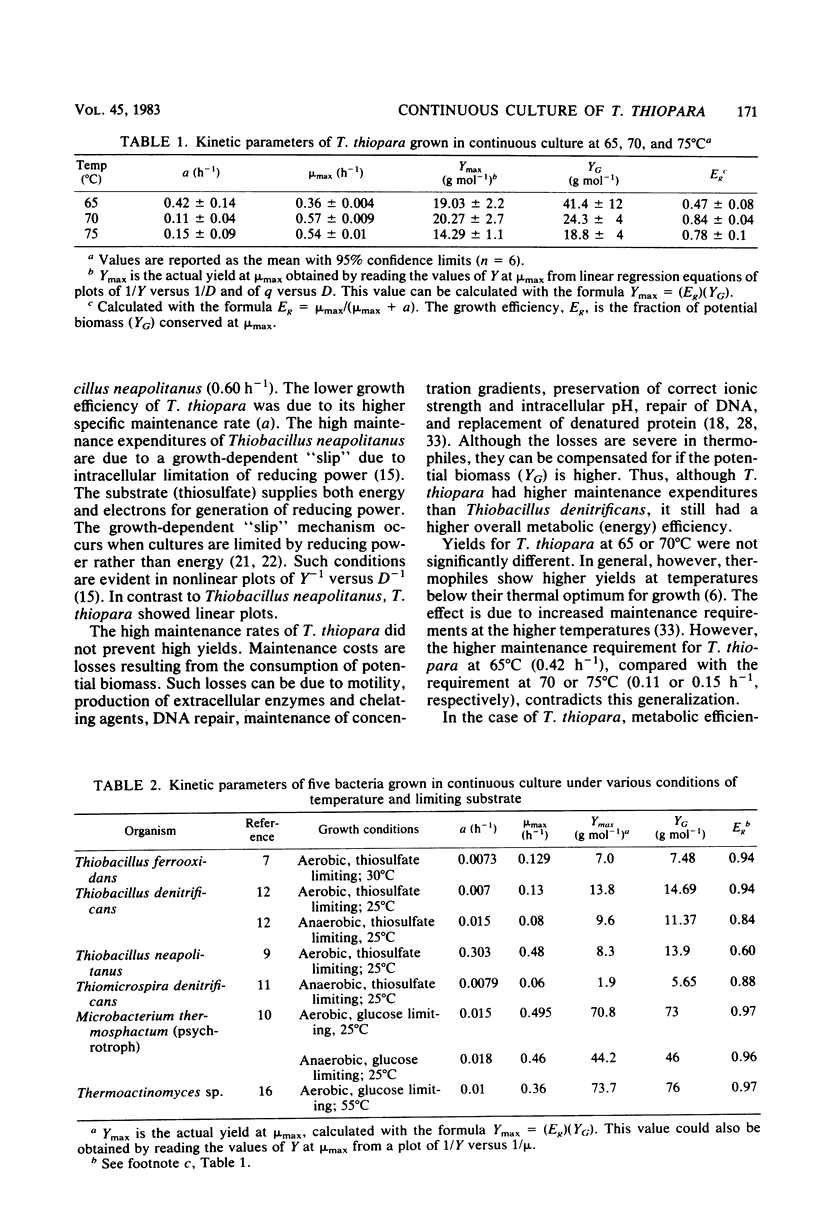Abstract
Thermothrix thiopara did not appear to be stressed at high temperature (72°C). Both the actual and theoretical yields were higher than those of analogous mesophilic sulfur bacteria, and the specific growth rate (μmax) was more rapid than that of most autotrophs. The specific growth rate (0.58 h−1), specific maintenance rate (0.11 h−1), actual molar growth yield at μmax (Ymax = 16 g mol−1), and theoretical molar growth yield (YG = 24 g mol−1) were all higher for T. thiopara (72°C) than for mesophilic (25 to 30°C) Thiobacillus spp. The growth efficiencies for T. thiopara at 70 and 75°C (0.84 and 0.78) were significantly higher than at 65°C (0.47). Corresponding specific maintenance rates were highest at 65°C (0.41 h−1) and lowest at 70 and 75°C (0.11 and 0.15 h−1, respectively). Growth efficiencies of metabolically similar mesophiles were generally higher than for T. thiopara. However, the actual yields at μmax were higher for T. thiopara because its theoretical yield was higher. Thus, at 70°C, T. thiopara was capable of deriving more metabolically useful energy from thiosulfate than were mesophilic sulfur bacteria at 25 and 30°C. The low growth efficiency of T. thiopara reflected higher maintenance expenditures. T. thiopara had higher maintenance rates than Thiobacillus ferroxidans or Thiobacillus denitrificans, but also attained higher molar growth yields. It is concluded that sulfur metabolism may be more efficient overall at extremely high temperatures due to increased theoretical yields despite increased maintenance requirements.
Full text
PDF




Selected References
These references are in PubMed. This may not be the complete list of references from this article.
- Brannan D. K., Caldwell D. E. Thermothrix thiopara: Growth and Metabolism of a Newly Isolated Thermophile Capable of Oxidizing Sulfur and Sulfur Compounds. Appl Environ Microbiol. 1980 Aug;40(2):211–216. doi: 10.1128/aem.40.2.211-216.1980. [DOI] [PMC free article] [PubMed] [Google Scholar]
- Brock T. D. Life at high temperatures. Evolutionary, ecological, and biochemical significance of organisms living in hot springs is discussed. Science. 1967 Nov;158(3804):1012–1019. doi: 10.1126/science.158.3804.1012. [DOI] [PubMed] [Google Scholar]
- Caldwell D. E., Caldwell S. J., Laycock J. P. Thermothrix thioparus gen. et sp. nov. a facultatively anaerobic facultative chemolithotroph living at neutral pH and high temperature. Can J Microbiol. 1976 Oct;22(10):1509–1517. doi: 10.1139/m76-223. [DOI] [PubMed] [Google Scholar]
- Coultate T. P., Sundaram T. K. Energetics of Bacillus stearothermophilus growth: molar growth yield and temperature effects on growth efficiency. J Bacteriol. 1975 Jan;121(1):55–64. doi: 10.1128/jb.121.1.55-64.1975. [DOI] [PMC free article] [PubMed] [Google Scholar]
- Eccleston M., Kelly D. P. Oxidation kinetics and chemostat growth kinetics of Thiobacillus ferrooxidans on tetrathionate and thiosulfate. J Bacteriol. 1978 Jun;134(3):718–727. doi: 10.1128/jb.134.3.718-727.1978. [DOI] [PMC free article] [PubMed] [Google Scholar]
- Gaughran E. R. THE THERMOPHILIC MICROORGANISMS. Bacteriol Rev. 1947 Sep;11(3):189–225. doi: 10.1128/br.11.3.189-225.1947. [DOI] [PMC free article] [PubMed] [Google Scholar]
- Hempfling W. P., Vishniac W. Yield coefficients of Thiobacillus neapolitanus in continuous culture. J Bacteriol. 1967 Mar;93(3):874–878. doi: 10.1128/jb.93.3.874-878.1967. [DOI] [PMC free article] [PubMed] [Google Scholar]
- Hitchener B. J., Egan A. F., Rogers P. J. Energetics of Microbacterium thermosphactum in glucose-limited continuous culture. Appl Environ Microbiol. 1979 Jun;37(6):1047–1052. doi: 10.1128/aem.37.6.1047-1052.1979. [DOI] [PMC free article] [PubMed] [Google Scholar]
- Ljungdahl L. G. Physiology of thermophilic bacteria. Adv Microb Physiol. 1979;19:149–243. doi: 10.1016/s0065-2911(08)60199-x. [DOI] [PubMed] [Google Scholar]
- Neijssel O. M., Tempest D. W. Bioenergetic aspects of aerobic growth of Klebsiella aerogenes NCTC 418 in carbon-limited and carbon-sufficient chemostat culture. Arch Microbiol. 1976 Mar 19;107(2):215–221. doi: 10.1007/BF00446843. [DOI] [PubMed] [Google Scholar]
- Neijssel O. M., Tempest D. W. The role of energy-spilling reactions in the growth of Klebsiella aerogenes NCTC 418 in aerobic chemostat culture. Arch Microbiol. 1976 Nov 2;110(23):305–311. doi: 10.1007/BF00690243. [DOI] [PubMed] [Google Scholar]
- Ng H. Effect of decreasing growth temperature on cell yield of Escherichia coli. J Bacteriol. 1969 Apr;98(1):232–237. doi: 10.1128/jb.98.1.232-237.1969. [DOI] [PMC free article] [PubMed] [Google Scholar]
- SENEZ J. C. Some considerations on the energetics of bacterial growth. Bacteriol Rev. 1962 Jun;26:95–107. [PMC free article] [PubMed] [Google Scholar]
- Sukatsch D. A., Johnson M. J. Bacterial cell production from hexadecane at high temperatures. Appl Microbiol. 1972 Mar;23(3):543–546. doi: 10.1128/am.23.3.543-546.1972. [DOI] [PMC free article] [PubMed] [Google Scholar]
- Taylor G. T., Pirt S. J. Nutrition and factors limiting the growth of a methanogenic bacterium (Methanobacterium thermoautotrophicum). Arch Microbiol. 1977 May 13;113(1-2):17–22. doi: 10.1007/BF00428574. [DOI] [PubMed] [Google Scholar]
- Timer-ten Hoor A. Cell yield and bioenergetics of Thiomicrospira denitrificans compared with Thiobacillus denitrificans. Antonie Van Leeuwenhoek. 1981;47(3):231–243. doi: 10.1007/BF00403394. [DOI] [PubMed] [Google Scholar]
- Weimer P. J., Zeikus J. G. Acetate metabolism in Methanosarcina barkeri. Arch Microbiol. 1978 Nov 13;119(2):175–182. doi: 10.1007/BF00964270. [DOI] [PubMed] [Google Scholar]


